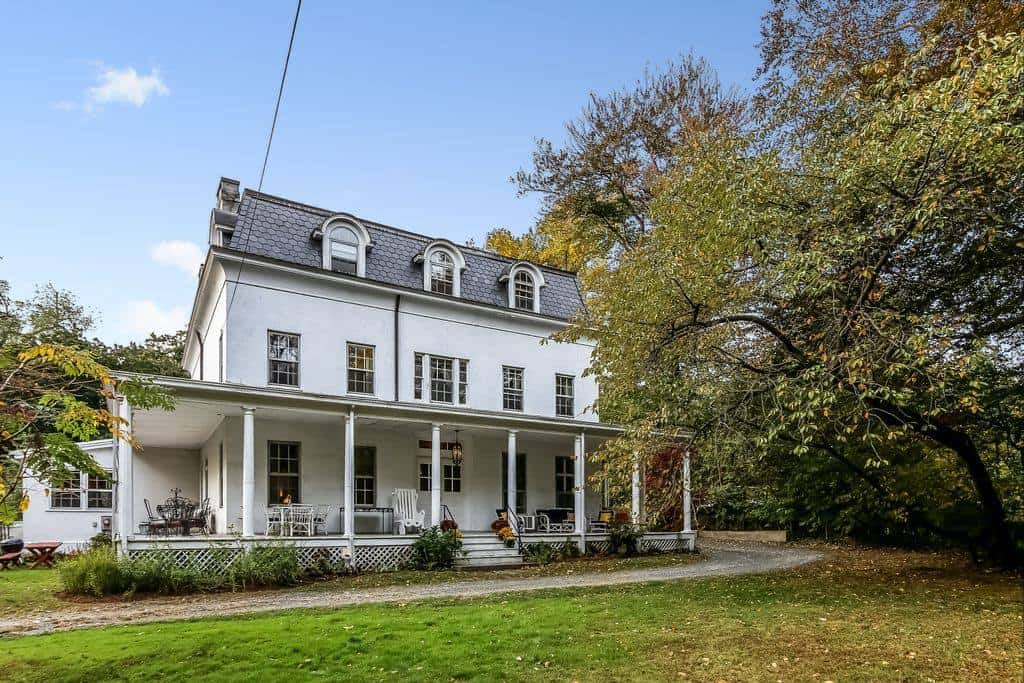
By Cindy Schwall
What do Fort Hill Road, Madeline Lengle, William Penn and Alexander Hamilton have in common? The John Archelaus Hammond House that sits on Fort Hill Road in Edgemont.
In the dead of winter, when the trees have dropped their leaves, I used to peek beyond the rambling stone wall, my eyes drawn to the stately white house with the Mansford roof set far back on Fort Hill Road. I wondered what secrets it held. There was a presence emanating from the house that called to me.
Years later, the hustle of lower Westchester County fell away as I drove past the ancient stone wall skirting the property, the gravel of the semi-circle driveway crunching under my tires. Entering its grounds, the sense of history was palpable.
The John Archelaus Hammond House is perched midway between Jackson and Central Avenue. The roughhewn stone wall surrounding the property is made from stone cut by Italian masons who were brought to New York in 1915 to build the Croton Aqueduct. In the back of the property, an ancient stone wall constructed with stacked fieldstones and no mortar dates back to pre-revolutionary times. In spring, a blue carpet of flowers speckles the acres surrounding this house that seems to be in the country, isolated from its neighbors.
In Edgemont, that’s a rarity – and this fine house is, too. And now it’s on the market and available to someone special who wants to own a piece of Westchester County’s history.
On Aug. 17, 1852, the house and its surrounding 42 acres was purchased for $5,000 by John Hammond, a lawyer in New York City who was very likely one of the first commuters in 1846, when the New York and Harlem Railroad began service in the Bronx River Valley. Since then the house has had several owners, but probably none as passionate about maintaining the integrity of the structure as Mrs. Louise Clark. She and her husband Phillip purchased the property in 1967 and went about creating a family while working on various restoration projects.
During renovations, Mrs. Clarke unearthed John Hammond’s diary and marveled at his neat script and the fact that he was most likely Westchester’s first gentleman farmer. Hammond kept a map of all of his fruit trees and recorded daily occurrences, such as “neighbor’s pigs damaged the garden… the Bronx River flooded… went to Sing Sing on business…” He also kept a detailed map of his garden and it lists six varieties of grapes, 10 varieties of apples, two varieties of cherries and six varieties of pears.
I’ve had the luxury of visiting the house and Mrs. Clarke, who is always gracious to share the property with others. Over the years I have always been willing to share the house whenever it could be shared. We needed a place for Madeleine L’Engle to meet to talk to parishioners from Saint James the Less. It was great. She talked and we had a reception in the dining room and she said, “Oh never change this wall paper.”
It was about 50 years old when we moved in. It’s been 50 years, but I can’t change that wall paper.
Madeleine L’Engle is not the only person who has visited the house; concerts have been held. Mrs. Clarke has hosted friends’ parties, choir picnics and birthday parties for entire school classes. Games were played, life guards were hired so everyone could swim, and the children called the home their summer place. Mrs. Clarke has also housed students from Westchester Community College who needed a temporary place to stay.
The first one was six years. One was a matter of months. I’ve kept up with all of them. They are like extended family members. One’s in Japan raising a family. One’s an actor in Hollywood. One’s in the chorus of the Metropolitan Opera. One’s a laywer. Another’s currently living in London.
“It’s fun to observe their careers,” she said. “They stayed here at some point in between college and a settled job, but we don’t charge rent. They become a member of the family. It’s nice to have them.”
And now this summer place, this safe haven and historical house, is up for sale. Ideally, Mrs. Clarke would like to continue the tradition of sharing her house with someone who loves the house and wants to maintain the historical features and who is interested in the history so that house would remain as a reminder in the community as to what our history is. There are only a few buildings around left in Edgemont that distinguish it from being just an ordinary suburb that remind you of what its past was. There are a few revolutionary houses. This house is pre-civil war, and it was the beginning of the community really.
Of course, some homeowners want a “McMansion,” or builders are looking to subdivide property; the worst of which would come in, tear down the house and build several new homes on the property. Mrs Clarke said: “I don’t want that to happen. They want it to look like all the other houses in Edgemont. I enjoy the old style. Really the cost is determined by the property it’s on. The asking price is what the property would bring in if there was no house on it. The house is a bonus as far as I’m concerned.”
Although, some folks might look at work that may need to be done, others would look at it for what it is: truly a one-of-a-kind home replete with history. It’s a structure that can’t be recreated from the grand staircase in the foyer to the beautifully carved mantelpieces to the wide plank floors in the kitchen – it simply can’t be duplicated. Stainless steel appliances and granite countertops will someday be the pink bathtubs of the 1970s and will fade out of style. This house never will.
Classic doesn’t go out of style and this house truly is a classic, just like its owner, Mrs. Clarke. Let’s try to keep it in the neighborhood by finding a new owner who will preserve and protect its history and that of Edgemont.
Reach Houlihan Lawrence and Cindy Schwall at 914-672-6424 or cschwall@houlihanlawrence.com.





